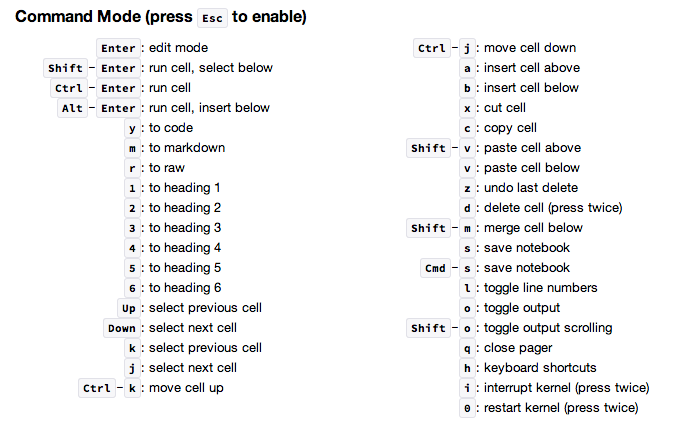Notebook User Interface¶
This notebook describes the user interface of the IPython Notebook. This includes both mouse and keyboard based navigation and interaction.
Overview of the UI¶
The notebook UI has the following main areas:
- Menu
- Toolbar
- Notebook area and cells
IPython 2.0 has an interactive tour of these elements that can be started in the "Help:User Interface Tour" menu item.
Modal editor¶
Starting with IPython 2.0, the IPython Notebook has a modal user interface. This means that the keyboard does different things depending on which mode the Notebook is in. There are two modes: edit mode and command mode.
Edit mode¶
Edit mode is indicated by a green cell border and a prompt showing in the editor area:

When a cell is in edit mode, you can type into the cell, like a normal text editor.
Command mode¶
Command mode is indicated by a grey cell border:

When you are in command mode, you are able to edit the notebook as a whole, but not type into individual cells. Most importantly, in command mode, the keyboard is mapped to a set of shortcuts that let you perform notebook and cell actions efficiently. For example, if you are in command mode and you press c, you will copy the current cell - no modifier is needed.
Mouse navigation¶
All navigation and actions in the Notebook are available using the mouse through the menubar and toolbar, which are both above the main Notebook area:

The first idea of mouse based navigation is that cells can be selected by clicking on them. The currently selected cell gets a grey or green border depending on whether the notebook is in edit or command mode. If you click inside a cell's editor area, you will enter edit mode. If you click on the prompt or output area of a cell you will enter command mode.
If you are running this notebook in a live session (not on http://nbviewer.ipython.org) try selecting different cells and going between edit and command mode. Try typing into a cell.
The second idea of mouse based navigation is that cell actions usually apply to the currently selected cell. Thus if you want to run the code in a cell, you would select it and click the <button></button> button in the toolbar or the "Cell:Run" menu item. Similarly, to copy a cell you would select it and click the <button></button> button in the toolbar or the "Edit:Copy" menu item. With this simple pattern, you should be able to do most everything you need with the mouse.
Markdown and heading cells have one other state that can be modified with the mouse. These cells can either be rendered or unrendered. When they are rendered, you will see a nice formatted representation of the cell's contents. When they are unrendered, you will see the raw text source of the cell. To render the selected cell with the mouse, click the <button></button> button in the toolbar or the "Cell:Run" menu item. To unrender the selected cell, double click on the cell.
Keyboard Navigation¶
The modal user interface of the IPython Notebook has been optimized for efficient keyboard usage. This is made possible by having two different sets of keyboard shortcuts: one set that is active in edit mode and another in command mode.
The most important keyboard shortcuts are Enter, which enters edit mode, and Esc, which enters command mode.
In edit mode, most of the keyboard is dedicated to typing into the cell's editor. Thus, in edit mode there are relatively few shortcuts:

In command mode, the entire keyboard is available for shortcuts, so there are many more:

We recommend learning the command mode shortcuts in the following rough order:
- Basic navigation:
enter,shift-enter,up/k,down/j - Saving the notebook:
s - Cell types:
y,m,1-6,t - Cell creation and movement:
a,b,ctrl+k,ctrl+j - Cell editing:
x,c,v,d,z,shift+= - Kernel operations:
i,.
Cell types¶
The notebook UI and notebook documents are a linear sequence of cells. There are four cell types:
- Code cells: Input and output of live code that is run in the kernel
- Markdown cells: Narrative text with embedded LaTeX equations
- Heading cells: 6 levels of hierarchical organization and formatting
- Raw cells: Unformatted text that is included, without modification, when notebooks are converted to different formats using nbconvert
More information about code and Markdown cell can be found in these tutorials:
- [Working With Code Cells](Working With Code Cells.ipynb)
- [Working With Markdown Cells](Working With Markdown Cells.ipynb)
